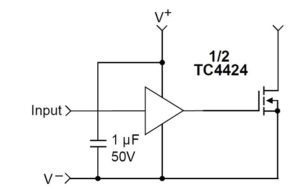The term “buffer” has many definitions in electronics hardware and software. It can be a reserved software area where data is temporarily stored until it is processes; a set of internal IC registers where data is queued before being transmitted or after it has been received; or it can be a circuit function interposed to interface between two subcircuits.
We will look at the latter role. Although these buffers often handle digital signals consisting of 1s and 0s, they are actually functioning in the real, analog world of voltage, current, time, and failures. As such, they are analog circuits handling real-world “digital” signals.
- What’s the difference between a buffer and a driver?
It is largely a matter of perspective. A buffer tends to be an interposed element which keeps the source from being affected by the load attributes, but delivers the same or nearly the same voltage and current it sees at its own input. A driver usually boosts the current source/sink level, or the voltage at which it delivers its output to its load. In many cases, the buffer and driver aspects are combined. Drivers often provide additional protection against circuit problems.
- What is the symbol for a buffer? How is the buffer/driver implemented?
The buffer symbol is a simple, Figure 1. The symbol does not begin to hint at the subtleties or internal complexities of many buffer. In many ICs, the buffer/driver is built into the source IC, but there are also many discrete buffer and driver ICs used, depending how much current has to be delivered and at what voltage levels. Note that buffers for analog signals usually use the same symbol as those for digital signals.
What does a buffer (or driver) do?
A basic buffer has a single input which is connected to a source’s output, and a single output which is connected to (or drives) the load’s input. As with most engineering questions, they are many answers to the question:
- A buffer can translate the voltage of the source to the voltage needed by the load
- It can allow a subcircuit with only low or modest current-source/sink capability to drive a load which requires more current to operate;
- It can provide protection for the source, in case the load has a fault such as a short circuit or inadvertent connection to the power rail;
- It can control and manage the timing between the source signal and the voltage/current as seen by the load (slew-rate control);
- It can insulate the source from any changes in the nature of the load, so the source sees a fixed, unchanging load.
- Some buffers invert the input signal to properly match the two subcircuits
Note that buffers generally do not change the frequency of the source, although they do in some cases.
What’s the difference between a buffer and a driver?
It is largely a matter of perspective. A buffer tends to be an interposed element which keeps the source from being affected by the load attributes, but delivers the same or nearly the same voltage and current it sees at its own input. A driver usually boosts the current source/sink level, or the voltage at which it delivers its output to its load. In many cases, the buffer and driver aspects are combined. Drivers often provide additional protection against circuit problems.
Why are buffers and drivers needed?
They are used extensively, since most IC outputs simply don’t have the capacity to provide what the load needs. For example:
A MOSFET driver takes the low-level digital signals from a processor or controller and delivers them with the high voltage and current which the MOSFET needs to be turned on, with the carefully managed slew rate and timing, Figure 2
- A MOSFET driver takes the low-level digital signals from a processor or controller and delivers them with the high voltage and current which the MOSFET needs to be turned on, with the carefully managed slew rate and timing, Figure 2
- Analog signals from the front-end amplifier of a radio receiver need to go to an analog/digital converter but that amplifier needs to see a constant impedance, rather than the variable impedance which the converter presents depending on operating conditions. The buffer ensures that this is the case;
- A programmable logic controller (PLC) state-machine processor needs to turn a relay on and off, and the relay needs 24 V and 1 A to operate, and also generates a high-voltage inductive “kick” when it is turned off; the driver not only translates between the two worlds but also protects the processor output;
- An IC with a 3-V IC needs to interface to an IC with a 5-V input (or vice versa) although the current levels are low; a buffer acts as the voltage translator;
These are just a few of many possible examples.
What is an isolated buffer?
There are situations were two subcircuits must be electrically isolated from each other – meaning there is no ohmic (galvanic) path between the two – yet signal information must go from one to the other. This isolation may be needed for system protection, operator safety, or because the MOSFETs in a standard motor-driver need to “float” without ground connection. An isolated buffer breaks the galvanic path by using an interposed path using an optical-coupler, a transformer’s magnetic path, a capacitive coupling, or even an RF link.
Despite the fact that buffers and drivers provide little or no added functionality or signal processing aspects. but primarily replicate their input at their output but with different attributes, they are essential components with key roles in a successful, viable design.


